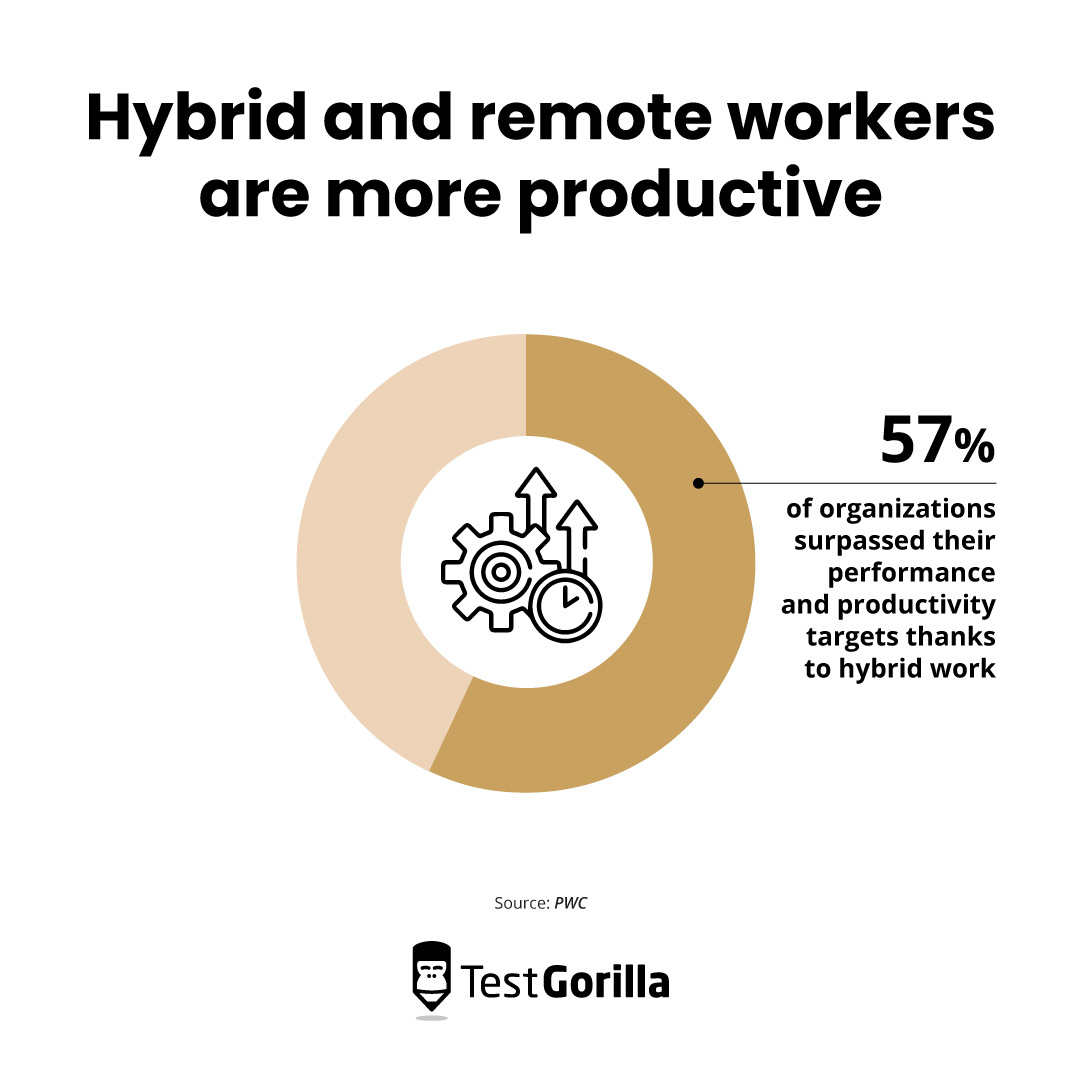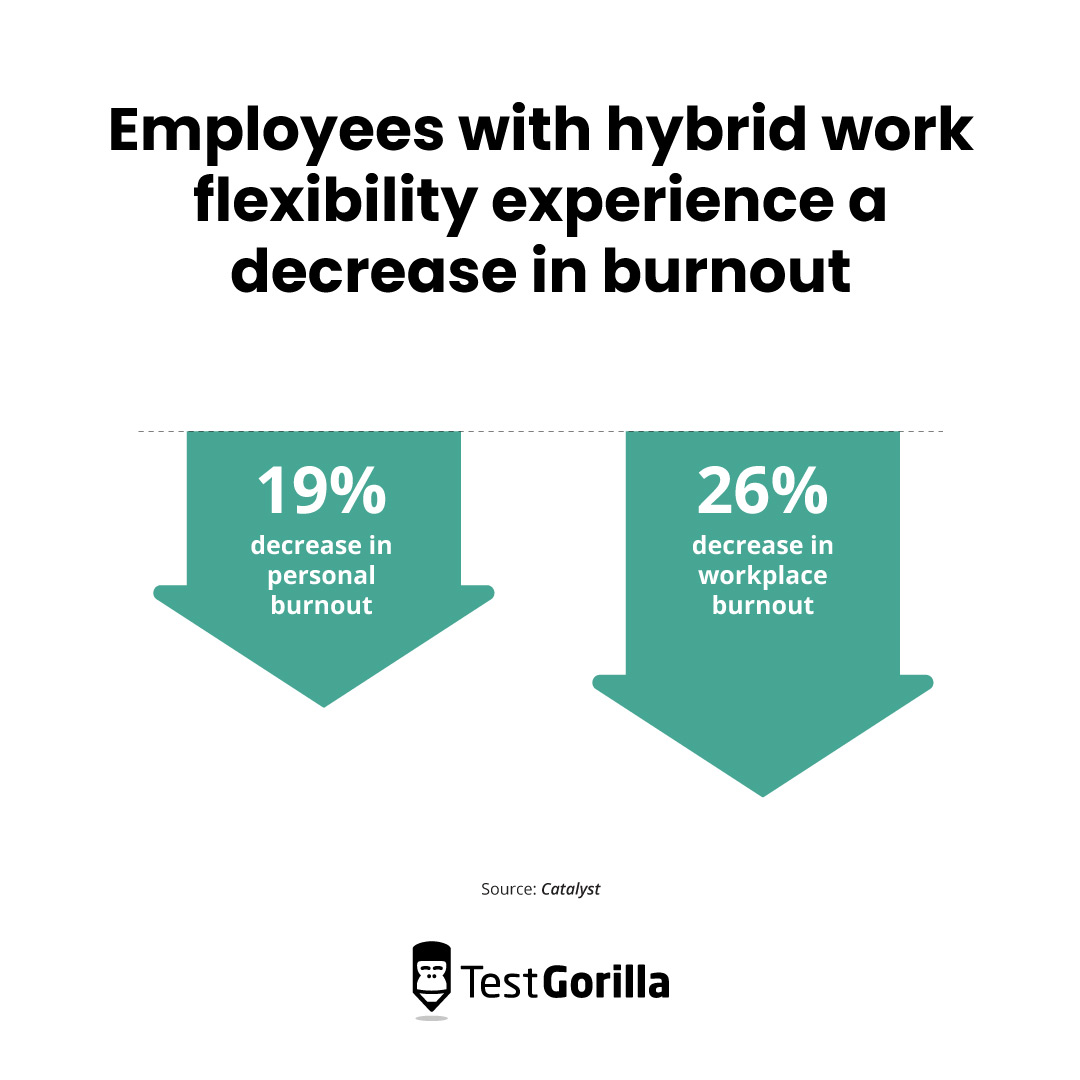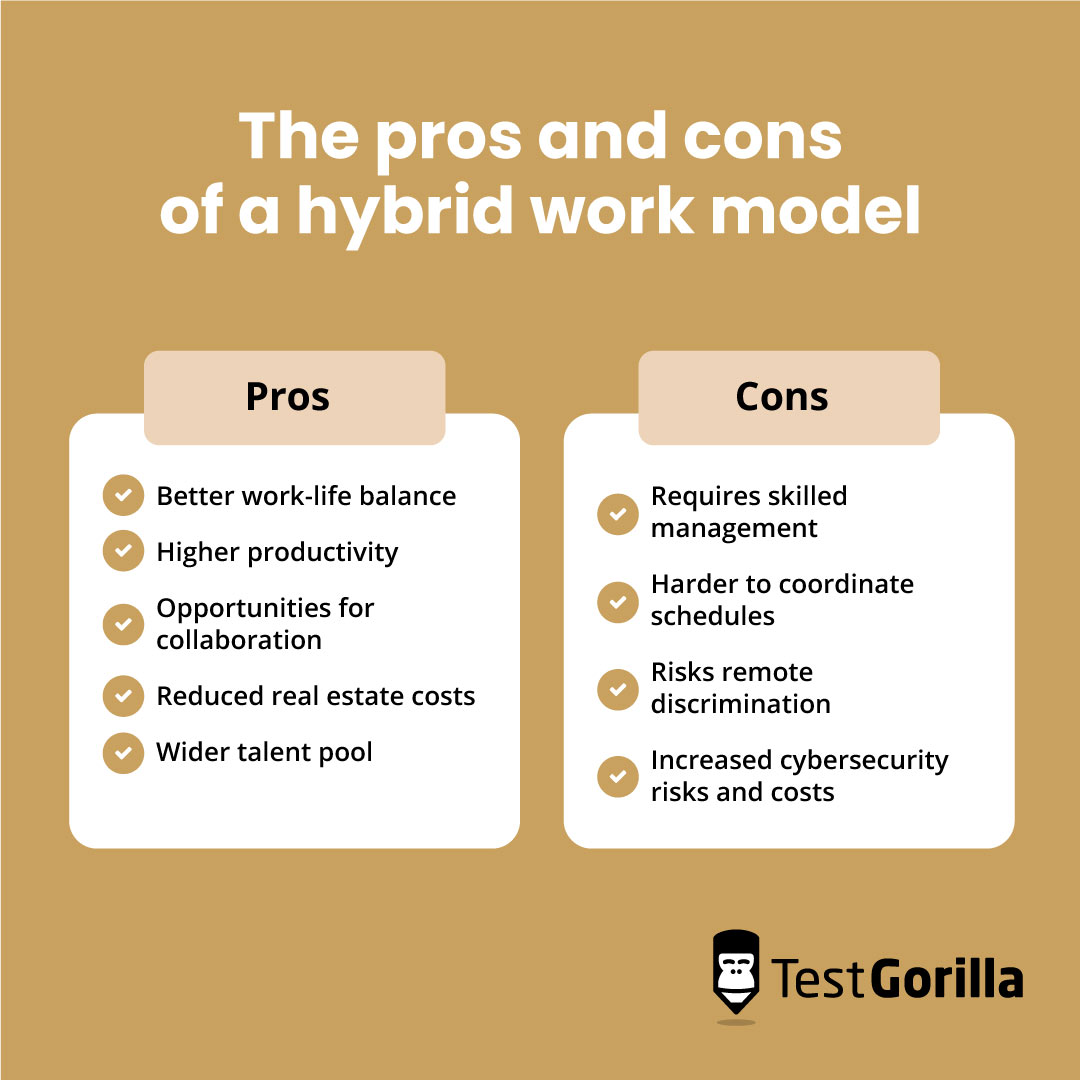The complete guide to hybrid work models: How to find the right one for your organization
Long after most companies have reopened their offices in the recovery from the COVID-19 pandemic, hybrid work structures are still going strong.
In fact, a McKinsey survey of 100 executives found that nine out of ten organizations will combine remote and on-site work in the long term.[1]
But building a remote team – even one that’s only partially remote – isn’t easy.
To make it work, you need to find the right hybrid work model to suit your company’s needs.
Then, you need to implement it in a way that avoids the common pitfalls of hybrid working: scheduling challenges, cybersecurity risks, and mistreatment of remote workers.
In this guide, we cover the different types of hybrid work models to help you choose the one that works for you. We also dig into the best practices for supporting hybrid work, from clear policy-making to testing new hires for remote skills.
Hybrid work can be for everyone, so let’s make it work for you.
Table of contents
- What is a hybrid work model?
- What factors are driving the demand for hybrid office models?
- The pros and cons of a hybrid work model
- 5 types of hybrid office models (and how to pick the right one)
- 7 hybrid work model best practices
- 4 hybrid work model examples: Success in the real world
- Hire for a hybrid work model with skills testing
What is a hybrid work model?
A hybrid work model is a flexible approach to working that supports a mixture of in-office and remote workers.
These employees form a hybrid office, which isn’t just a physical office – it’s also a digital space in which coworkers collaborate.
Remote workers might work from home, from a coworking space, or even while commuting or traveling.
Interest in this approach increased in response to stay-at-home orders issued across the globe during the COVID-19 pandemic.
But years later, the hybrid model is still going strong. According to Owl Labs’ State of Remote Work Report, in 2022, the number of workers choosing hybrid work schedules increased by 16%.
Today, many younger workers who joined the workforce during or after the pandemic have only ever worked remotely, so this guide may even help some adjust to partial in-person collaboration after years of only working remotely.
What factors are driving the demand for hybrid office models?
You might expect the popularity of hybrid office models to wane in the aftermath of the pandemic. Instead, the hybrid work model continues to be on the rise.
That’s partly driven by employee preferences. Research from Buffer shows that 98% of employees want to work remotely, at least part of the time, for the rest of their careers.
In addition, Owl Labs’ State of Remote Work report reveals that if they were no longer given the opportunity to work remotely, 67% of workers would expect a pay increase to compensate.
Meanwhile, 46% would “quiet quit” – phoning in their jobs until they can find new employment that fulfills their remote work preferences – dealing serious blows to productivity and profit for their current employers.
Another factor is the productivity of hybrid and remote workers. According to PwC, 57% of organizations reported surpassing their performance and productivity targets over the past 12 months thanks to hybrid work.
Hybrid work models set workers up for increased success, employee engagement, and job satisfaction – hence their ongoing popularity.
The best insights on HR and recruitment, delivered to your inbox.
Biweekly updates. No spam. Unsubscribe any time.
The pros and cons of a hybrid work model
So, should you implement a new hybrid work model for your business?
In this section, we weigh the benefits of a hybrid work model against its disadvantages.
The pros of hybrid work models at a glance
Better work-life balance
We all wish there were more hours in the day, but telecommuting is the next best thing. It gives employees greater flexibility and more control over their day-to-day lives.
That flexibility yields great results for employee mental health and, therefore, great results for your employees’ satisfaction with and commitment to their work.
Research from Catalyst shows that employees with remote work access experience a 19% decrease in personal burnout and a 26% decrease in workplace burnout and. That’s great news for employers who want their staff to be healthy and present, wherever they work.
Higher productivity
Hybrid work doesn’t just make your employees happier. It helps them work more productively. That’s why 63% of high-revenue-growth companies have implemented a hybrid work model.
The key to these productivity gains lies in creating a solid hybrid work model policy that guides employees in managing their work according to their environment.
For instance, employees should perform work in-office that relies on office-located tools and software but should concentrate on less environment-intensive work when remote.
Opportunities for collaboration
Many employers believe a fully remote work environment limits opportunities for staff to collaborate with each other. Spontaneous water cooler chats that generate new ideas are harder to enable remotely, for example.
As we’ve seen, remote work access decreases employee burnout. How can businesses reconcile the two?
Research from Gallup shows that:
Employees prioritize collaboration, contact with managers, and the use of location-specific technology when working from the office
Workers focus on head-down, independent work tasks without distractions when working from home[2]
A hybrid office model gives workers and businesses alike the best of both worlds. It enables employees to collaborate when necessary without losing the ability to focus independently when needed.
Reduced real estate costs
Hybrid work models leave office spaces emptier. That presents a great opportunity to downsize to a smaller office and reinvest your money into other areas of your business.
Even if you opt for a hybrid office model in which employees have to work in the office on a rotating basis, you still save on office expenses.
Specifically, Global Workplace Analytics estimates that the average US employer stands to save an average of $11,000 per halftime remote worker each year.
Wider talent pool
Offering workers a hybrid office model gives you access to a wider talent pool.
When you implement a hybrid remote/in-office mix in which many of your workers are fully remote, remote hiring gives you access to professionals across the country or worldwide who would otherwise be out of reach.
Even if you adopt a split-week or at-will model, your inclusive practices will pull in a wider range of candidates.
That’s especially true of disabled workers. The employment rate for people with disabilities has increased by 3.5% since remote and hybrid approaches to work became widespread.
The cons of hybrid work models at a glance
Requires skilled management
When managing a hybrid office, it takes effort to combat:
The lack of an in-built routine for employees
Employee isolation compared with a central office
Communication gaps in asynchronous working
The limitations of text communication compared with face-to-face interactions
You need an airtight hybrid work policy to make it work.
Harder to coordinate schedules
Remote employees can work from anywhere. This means your team may be spread across a wide range of countries and time zones.
This creates challenges in bringing workers together in real-time. It could lead to workers in Europe staying up late to meet with workers on the North American Pacific coast, for example.
Set clear expectations around work hours and availability by using digital channels where employees can communicate asynchronously or implementing a flexible work policy that enables workers to set their own work hours.
Risks remote discrimination
If you worry that you’re “out of sight, out of mind” for your workers, they have the same worry about you.
Research shows that 42% of supervisors say they sometimes forget about remote workers when assigning tasks, and 34% of remote workers say working remotely on a permanent basis would reduce the number of career opportunities available to them.
This can lead to “remote discrimination,” with remote workers receiving fewer advancement opportunities – or simply being forgotten about because their managers can’t interact with them in person.
Counter this issue with a clear hybrid work policy and a cohesive remote culture that includes everyone.
Increased cybersecurity risks and costs
In a hybrid work model, employees access sensitive or confidential company data from home more often, so there are more opportunities for security breaches.
According to an OpenVPN survey, 36% of businesses reported experiencing a security breach due to unsecured remote workers.
However, 92% of IT professionals said the benefits of hybrid work outweighed the risks.[3]
The way to deal with security vulnerabilities is by implementing strict cybersecurity protocols – more on these down below.
Learn more about the pros and cons of hybrid work in our comprehensive guide to hybrid work statistics.
5 types of hybrid office models (and how to pick the right one)
Not all hybrid office models are the same. It’s possible to choose from a wide range of models, depending on your unique needs and circumstances.
Here’s a guide to some of the most popular approaches and their use cases.
Hybrid office model types at a glance
Type of model | Where it works best |
1. Hybrid at-will | Companies without the need for on-site work functions; companies that require in-person meetings |
2. Remote-first hybrid split-week | Companies with a limited amount of on-site work functions |
3. Office-first hybrid split-week | Companies reliant on on-site work functions or intensive collaboration |
4. Hybrid manager-scheduling | Companies with high trust between workers and management; companies working on a project-by-project basis |
5. Remote and in-office mix | Companies with clear divisions between teams; companies with important on-site work functions |
1. Hybrid at-will
Employees have total control over their schedules in a hybrid at-will system. The company provides a coworking-like environment in which employees can book workspaces and meeting rooms when they need to come in.
Otherwise, workers are expected to work remotely.
Although this might sound like a free-for-all, there are usually rules attached to this system to reduce the burden on management, such as:
The requirement to book a desk if you want to be in the office
Limits to how often you can go into the office per week
Requirements for attending certain in-person meetings
The main advantages of this model are:
Employees can choose the most efficient way to work
Workers feel trusted and respected
The main disadvantages are:
You may end up paying for underutilized office space
Employee work patterns may be unpredictable
It requires you to trust your employees’ judgments
This model is great for companies whose work functions primarily don’t need to be carried out on-site, but which still benefit from the option to hold in-person meetings with clients or external stakeholders.
2. Remote-first hybrid split-week
The split-week remote-first approach offers a middle ground between the at-will model and the split-week office-first model. Although workers are expected to spend some time in the office, they are allowed to prioritize remote work.
For example, managers might ask these hybrid employees to come into the office one day a week to conduct in-person meetings and see their coworkers. But the rest of the time, they’re expected to work elsewhere.
It’s more rigorous than the at-will model, with less scope for spontaneous in-office work. Managers might schedule in-office days with employees in advance.
The main advantages of this model are:
High levels of flexibility for employees, boosting satisfaction and engagement
Workers feel like they have a high level of autonomy
The main disadvantages are:
It isn’t ideal for employees who prefer in-office work
It doesn’t decrease office expenses
This approach works well if you only need a limited amount of work to be completed on-site.
3. Office-first hybrid split-week
Like the remote-first hybrid split-week model, this approach balances in-office work with remote work. But here, the balance favors office-based working.
A manager might require a team to work from the office three days a week, scheduled in advance. Employees can work remotely on the remaining two days.
Alternatively, a company might mandate that employees need to spend 60% of their time in the office each month. That way, if a worker spends a full week in the office, they have the option to work remotely for four out of five days the following week.
The main advantages of this model are:
It offers employees some flexibility
It encourages collaboration
It doesn’t require many adjustments to existing ways of working
The main disadvantages are:
It may reduce productivity for employees who live far away from the office
Depending on the strictness of the policy, it may foster resentment
This model works best for companies that rely on collaborative work or work that can only be carried out on-site. For example, this is the only viable approach for construction or manufacturing firms that seek to reduce their on-site presence.
4. Hybrid manager-scheduling
In this work arrangement, the line manager of each team within a company determines when employees work from the office or from home.
This enables specific teams plenty of flexibility. Teams that need to work on-site may prioritize in-office work, while primarily digital teams may schedule only a minimal presence in the office.
But usually, each team ensures a minimum level of office coverage so their office space is never entirely empty.
The main advantages of this model are:
It ensures that each team has some presence in the office
Office space remains in use
It enables managers to focus on maximizing the needs of projects as they change
The main disadvantages are:
It relies heavily on manager fairness
It may not be the most efficient way for largely-digital teams to work
Because work locations are scheduled in advance, responding to emergencies is more challenging
This is a good approach for companies that work on a project-by-project basis and whose office staffing needs shift accordingly. It also works well when team members trust their managers.
5. Remote and in-office mix
A remote and in-office mix is a model that involves categorizing your workers into two types: full-time remote workers and full-time on-site workers.
You could leave it up to individual employees to determine which working style they prefer. Alternatively, you could implement the model on a role-by-role or team-by-team basis.
For example, you could make your web development team fully remote since their work is mainly digital. At the same time, you could keep your sales teams in the office because they do more client-facing work.
The main advantages of this model are:
Almost any company can implement it
It saves money on real estate costs
It maintains efficiency for both on- and off-site workers
The main disadvantages are:
It may foster resentment between remote and in-office workers
It increases reliance on technology
Consider adopting this approach if your organization has clear delineations between the responsibilities of different teams, or if it relies on important on-site functions.
7 hybrid work model best practices
Once you’ve chosen your model, you need to implement it effectively.
Use these best practices to guide your hybrid office model and ensure it’s as successful as possible.
Hybrid work model best practices at a glance
Best practice | How it helps |
1. Create a crystal-clear hybrid work policy | Clarifies expectations around both remote and in-person work for all parties |
2. Set strict cybersecurity protocols | Limits the risk of data breaches due to at-home work |
3. Ensure you have (and maintain) a cohesive company culture | Brings employees together and keeps them engaged despite the distance |
4. Invest in the right technology tools and train your workforce to use them | Empowers your employees to succeed while working remotely |
5. Pay attention to diversity and inclusion | Ensures all workers are given equal opportunities for success, whatever their background and wherever they work from |
6. Plan remote work according to roles and tasks | Prepares your company to embrace new ways of working |
7. Source talent that is well-suited to remote culture | Ensures that you recruit candidates with the remote work skills needed to thrive in a hybrid environment |
1. Create a crystal-clear hybrid work policy
First, outline a clear hybrid work policy that answers these key questions:
Who gets to work from home, and when/how often?
Who is in charge of deciding employees’ schedules?
What support will you be giving remote employees? This includes laptops, desk chairs, and microphone setups for meetings.
It’s also essential to clarify your employees’ and managers’ expectations for important processes like:
Team meetings and reviews
Check-ins and status reports
Outcomes and performance reviews
Determining working hours and availability
Dealing with urgent issues
Most of the disadvantages of hybrid work models we discussed earlier could be mitigated or solved with a clear hybrid work policy. Policies like this clarify expectations for everyone and minimize the friction arising from the challenges we discussed earlier.
To learn more about setting a hybrid work policy, read our post on remote work best practices.
2. Set strict cybersecurity protocols
As mentioned above, hybrid workforces can create more scope for cybersecurity issues. Employees’ remote workspaces may not have the same protections as traditional offices. This is particularly concerning if you work with sensitive data.
You need to set clear guidelines on where and how sensitive information can be stored and accessed by users in and out of the office. One way to address this is by investing in secure servers.
It’s also crucial to provide training for employees on the importance of data security and the safe use of key software.
The Verizon Data Breach Investigations Report found that although the biggest cybersecurity threats to businesses come from outside actors, employee error is still a significant factor.[4]
So close as many gaps in your cybersecurity protocols as possible through training and sensible infrastructural investment.
3. Ensure you have (and maintain) a cohesive company culture
Building a cohesive culture in a hybrid organization is a challenge. You can’t just put out some pizzas and let the magic happen as you would in a traditional office setting (although, if we’re honest, we’re not sure this even worked in the first place).
You have to intentionally engage your employees throughout the employee life cycle, which includes:
The hiring process
Regular employment reviews
Development and promotions
The notice period and exit interviews
Make them feel respected, listened to, and valued. Consider offering remote socials, 1:1 meetings with senior leadership via Zoom, and company-wide remote events and competitions tracked via Slack.
These initiatives bring people together around your company’s shared values. They’re an important way to maintain a cohesive culture, wherever your teams are based.
4. Invest in the right technology tools and train your workforce to use them
With so much work happening online, you need to invest in the right collaboration tools. These include:
Virtual private network (VPN) technology to protect employees’ internet connections
Cloud-based project management tools and customer relationship management software
Video conferencing software (don’t assume that Zoom is the best for everything; shop around)
We recommend being picky. Don’t overwhelm your workforce with apps they don’t need. Instead, choose a few powerful ones that help smooth your processes.
Once you’ve set up your tech, focus on the digital dexterity of your employees.[5]
This term refers to an employee’s ability to adopt and use new technologies to achieve business success. You can improve digital dexterity in your business by:
Investing in learning – organizations that actively promote employee skill development increase their employees’ skill preparedness by up to 28% more than self-service options
Using people who don’t work in IT but have a good digital understanding to translate concepts for others
Nominating employees to be “skills disseminators” to coach other employees
5. Pay attention to diversity and inclusion
We’ve mentioned an important danger of hybrid working: remote discrimination, in which remote workers are given fewer opportunities to advance.
Depending on your company’s approach to diversity and inclusion more broadly, this problem may intersect with other forms of workplace discrimination, including gender and race discrimination.
When embracing hybrid work models, ensure your focus on diversity and inclusion remains as strong as ever. Be intentional in championing diversity in ways that don’t leave out your remote staff, like:
Offering remote-friendly diversity and inclusion training sessions
Setting up employee resource groups so staff can express their needs
Providing coaching and mentorship schemes for workers from underrepresented groups
Hybrid working gives you a unique opportunity to hire remote workers from all over the world, fostering greater diversity. Use it to your advantage, and don’t undermine it through carelessness.
6. Plan remote work according to roles and tasks
The world of work is changing, and a hybrid work environment puts you in a great position to adapt to those changes.
Research from Deloitte indicates that traditional jobs might soon be a thing of the past. The firm proposes two new approaches that could replace them: [6]
Fractionalized work – breaking jobs down into specific tasks and assigning tasks to employees based on their skills and abilities
Broadened work – expanding jobs to place the focus on broader outcomes and giving employees freedom to reach those outcomes however they see fit
Either way, unbundling work from jobs gives employees more flexibility to flow to the areas where their skills and experiences are needed. In an increasingly global world, that’s likely to mean an uptick in hybrid work.
Consider assigning work, and work locations, on a case-by-case basis, depending on the needs of each project or task and the strengths of each employee. The hybrid manager-scheduling model works especially well here.
It means your workforce stays agile and adaptable in a competitive landscape, and your employees reap the benefits of a more flexible approach to work.
7. Source talent that is well-suited to remote culture
Finally, tailor your remote recruiting program to bring in candidates who can add to your remote work culture.
This may mean identifying the remote work skills they possess, including crucial digital skills. To accomplish this, determine what kind of tech users they are:
Caretakers
Believe that digital skills don’t help them and that their organization gives them poor technology
Support uniformity of device and application use
Express, by far, the lowest satisfaction with IT
Engineers
Late-career expert in digital technology who are satisfied with their work
Have the most affinity with senior managers and believe them to be in touch with digital technology
In a strong position in their organization and are likely IT workers or managers
Mavericks
Younger workers who bring their own technology to work and have distinct attitudes about digital work
Commonly work in IT department and are fairly common in sales and management
Just 29% strongly agree that their organization taps their personal digital skills
Navigators
Mid-career and deft, but not expert, with digital technology
Keenest to seek time to work from home 35% of the time, on average
Place more value on digital skills than most other segments
Pilots
Mid-career, comfortable with technology, and spend less time at their desks
Consider that their career benefits from their ability to develop digital skills
Extend their skills to use devices and applications that their organization authorizes or that they obtain without the organization’s authorization
You can also assess their interpersonal skills. These might seem less important in a more dispersed workforce.
But Harvard researchers have identified the “hybrid paradox,” which dictates that although interpersonal interaction is less frequent in a hybrid workplace, interpersonal skills are highly valuable.[7]
For example, they’re indispensable for chairing meetings and managing remote relationships.
Evaluate them using pre-employment testing, which makes it easy to compare candidates’ competencies and ability to add to your culture.
4 hybrid work model examples: Success in the real world
Ready to see how hybrid work models work in practice?
These examples of companies with a hybrid work model show that it’s possible to succeed with this approach.
HubSpot
HubSpot, a marketing software firm, allows employees to choose one of three work models:[8]
Office: Employees come into the office at least three days a week and have dedicated desks, in an office-first hybrid split-week approach. HubSpot does not provide a work-from-home setup.
Flex: Employees work in the office a maximum of two days per week on a remote-first hybrid split-week basis. They use “hotel desks” in the office and a supported work-from-home setup.
Home: HubSpot sets up employees to do their work almost entirely from home.
All employees have the option to change their work model once per year, enabling them to adapt to changing circumstances.
Capital One
At Capital One, a bank holding company, Mondays and Fridays are enterprise-wide remote work days.[9] Employees are “strongly encouraged” – though not forced – to work in the office on the days in between.
This hybrid split-week approach strikes a balance between the benefits of remote working and the advantages of in-office collaboration. It concentrates employees in the office on certain days to maximize the benefits of in-person teamwork and socializing.
Uber
Uber, the ride-share company, developed a hybrid work model for its corporate workers that’s responsive to employee feedback.
In 2022, it designated Tuesdays and Thursdays as “anchor days,” where all non-remote employees are expected to work from the office.[10]
This change came in response to feedback that coordinating in-office work with peers had proven challenging under the previous approach.
The firm’s policy also specifies that:
Employees must spend at least half of their work time in the office
Employees can work from anywhere for at least four weeks per year
Some employees, depending on their role and location, can be fully remote
It’s a slightly more flexible approach to the hybrid split-week model.
Deutsche Bank
At Deutsche Bank, an international bank, employees considered “in scope” for hybrid work have the option to spend up to 60% of their time working remotely.[11]
96% of the workforce is considered in scope for hybrid working, and 87% of employees feel productive under this model.
This approach combines the split-week and in-office mix approaches – not all employees have the option to work remotely, and most employees need to spend some time in the office.
Hire for a hybrid work model with skills testing
The pandemic may have introduced us to hybrid working, but there’s no doubt that the hybrid work model is here to stay.
From employee satisfaction to company productivity, the benefits of the hybrid work model are wide-ranging and impossible to deny.
With clear leadership, smart investment in cybersecurity and tech, and a strong skills-based talent sourcing policy, the hybrid work model could change the way you do business for the better.
Learn more about remote recruiting with our in-depth guide.
When you’re ready to start hiring, use our Culture Add test to measure your candidates’ abilities to add to your remote culture.
Sources
1. “What executives are saying about the future of hybrid work”. (May 17, 2021). McKinsey & Company. Retrieved August 24, 2023. https://www.mckinsey.com/business-functions/people-and-organizational-performance/our-insights/what-executives-are-saying-about-the-future-of-hybrid-work
2. Wigert, Ben; White, Jessica. (September 14, 2022). “The Advantages and Challenges of Hybrid Work”. Gallup. Retrieved September 8, 2023. https://www.gallup.com/workplace/398135/advantages-challenges-hybrid-work.aspx
3. “Remote Work Is the Future — But Is Your Organization Ready for It?”. (March 25, 2019). OpenVPN. Retrieved August 23, 2023. https://openvpn.net/blog/remote-workforce-cybersecurity-quick-poll/
4. “2022 DBIR Master's Guide”. Verizon. Retrieved September 8, 2023. https://www.verizon.com/business/resources/reports/dbir/2022/master-guide/
5. Kropp, Brian; Smith, Alison; Cain, Matt. (October 4, 2021). “How to Build Digital Dexterity Into Your Workforce”. Harvard Business Review. Retrieved September 8, 2023. https://hbr.org/2021/10/how-to-build-digital-dexterity-into-your-workforce
6. Cantrell, Susan. (October 26, 2021). “Beyond the job”. Deloitte. Retrieved September 8, 2023. https://www2.deloitte.com/us/en/insights/topics/talent/new-work-models.html
7. Heikinnen, Kate, et al. (June 28, 2021). “4 Imperatives for Managing in a Hybrid World”. Harvard Business Review. Retrieved September 8, 2023. https://hbr.org/2021/06/4-imperatives-for-managing-in-a-hybrid-world
8. Burke, Katie. (January 19, 2023). “The Future of Work at HubSpot”. HubSpot. Retrieved September 8, 2023. https://www.hubspot.com/careers-blog/future-of-work-hybrid
9. Fairbank, Rich. (May 18, 2022). “Capital One’s U.S. Offices Fully Hybrid September 6”. Capital One. Retrieved September 8, 2023. https://www.capitalone.com/about/newsroom/reopen-hybrid-work/
10. Krishnamurthy, Nikki. (October 4, 2022). “Our return to the office”. Uber. Retrieved September 8, 2023. https://www.uber.com/en-DE/blog/our-return-to-the-office/
11. “Hybrid working and beyond”. Deutsche Bank. Retrieved September 8, 2023. https://careers.db.com/inside-deutsche-bank/hybrid-working-and-beyond
You've scrolled this far
Why not try TestGorilla for free, and see what happens when you put skills first.


















